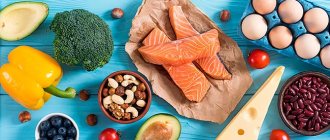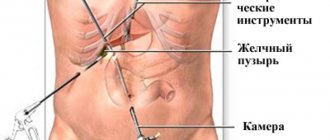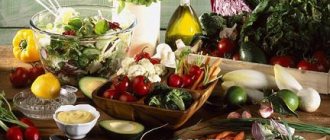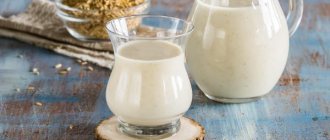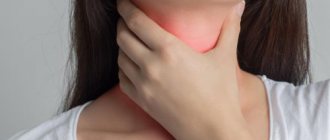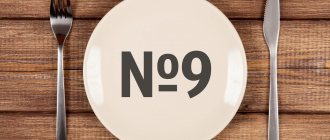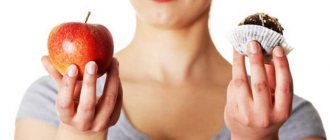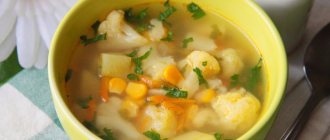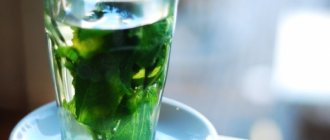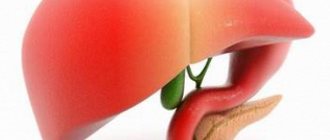Cholecystitis – gallbladder disease. This organ produces bile, which is necessary for the functioning of the gastrointestinal tract - the digestion of fats. If the functioning of the gallbladder is impaired, problems arise, so it is necessary to adhere to certain nutritional rules during this period.
Inflammation can be acute or chronic, depending on the stage of the disease, the types of diet for cholecystitis and the rules for maintaining them are different.
Pros of diet for pancreatitis
The pancreas produces enzymes that are released into the duodenum and participate in the process of digesting food. With pancreatitis, due to such provoking factors as alcohol abuse, exacerbation of cholelithiasis, the outflow of pancreatic juice does not occur, and enzymes begin to act directly on the gland, i.e. the process of self-digestion begins.
The disease is characterized by acute pain in the area where the gland is located, accompanied by nausea and vomiting. Table No. 5 excludes difficult-to-digest foods to ease the work of the inflamed organ.
If the patient does not comply with the diet, salty and fatty foods irritate the gastric mucosa and increase the level of acidity, and since the gland does not work fully, food is poorly digested and takes a long time, and the patient’s well-being worsens.
Some patients suffer from a shortage of tasty, but harmful foods, which can not be completely excluded, you just have to learn how to prepare them correctly.
Table No. 5 allows people who are obese to lose weight. Patients who strictly adhere to the diet lose up to 5 kg per week.
Features of diet therapy
For symptoms of cholecystitis, diet therapy is an important component of therapy. It is prescribed for acute forms of the disease, exacerbations of chronic cholecystitis, cholangitis.
The main diet for people with cholecystitis is table No. 5 and its types. The diet for inflammation is selected individually depending on the stage of progression of the pathology and the characteristics of its course.
Diet therapy eliminates any irritants, which is why food needs to be steamed, and before eating, food needs to be wiped or finely chopped. Spicy and fatty foods are excluded, and in case of cholelithiasis, you must additionally avoid egg yolks and vegetable oils, which have a strong choleretic effect, otherwise hepatic colic may occur.
General rules of the “5th table” diet
The developer of a complex of diets for patients with various diseases was nutritionist and gastroenterologist M.I. Pevzner, who outlined a list of permitted and prohibited foods for each disease.
The characteristics of the diet according to Pevzner “Table number 5” are as follows:
- Eating food with a normal content of proteins and carbohydrates.
- Reduction or complete refusal (depending on the degree of pathology) from fat-containing foods.
- Using boiling, stewing, baking in cooking. Ingredients with a lot of fiber should be pureed or finely chopped.
- Prohibition on eating cold foods (aspic, jelly, ice cream, etc.).
- Exclusion from the diet of foods high in oxalic acid and purines.
- Moderate salt intake.
You need to eat 5 times a day in small portions. In the morning, before breakfast, it is recommended to drink a glass of water.
For cholecystitis
In case of chronic cholecystitis, the following food intake rules are observed:
- Eat at the same time at least 5 times a day to stimulate the flow of bile.
- Take more than 700 g of food at a time, no more than 3.5 kg per day.
- Drink about 2 liters of liquid per day (including tea with lemon).
- Avoid foods that contain complex carbohydrates.
- Boil or steam food.
- Do not eat too hot foods.
For cholelithiasis
Diet 5p is a variation of table No. 5 and is recommended for diseases of the gallbladder and pancreas.
Diet features:
- do not overeat or starve, eat according to the clock;
- do not use spices and seasonings when cooking;
- limit consumption of simple fats;
- include permitted fruits and vegetables in the main diet;
- Avoid fried foods completely.
After gallbladder removal
If the gallbladder is removed, you must adhere to the 5a diet, the features of which are:
- reducing to a minimum the amount of fat consumed;
- chopping prepared foods (cutting them into small cubes, grating them or grinding them in a blender);
- excluding mushrooms, fatty fish and meat, legumes from the diet;
- a ban on ready-made store-bought sauces (mayonnaise, ketchup, mustard, horseradish, adjika);
- eating boiled vegetables.
Reviews and results
Feedback from patients confirms the need for therapeutic nutrition. As a result, their condition improves significantly: heaviness in the right hypochondrium, bloating of the intestines decrease, belching and constipation disappear. Patients note that the diet is easily tolerated; the only inconvenience is the need for individual preparation, which requires additional time.
- “... During an exacerbation, I was treated in a hospital and was prescribed a diet, which I have continued to follow for 2 months. I feel very good, all the symptoms that worried me have disappeared: there is no bitterness, heaviness under the rib, bloating and belching, lightness has appeared in the intestines. I would like to follow it longer, but the difficulty is that I have to cook for myself separately, and a working person does not have time for this. It’s bad that my family doesn’t support me in nutrition”;
- “... After having my gall bladder removed, I eat like this all the time. I’m used to it, the food is nutritious, almost all foods are okay, except fatty and fried ones, so everything is fine. I feel good, and I’ve also lost weight. True, sometimes I allow myself “liberties” on holidays, and then again I strictly observe them. I can say for sure that therapeutic nutrition makes sense, only difficulties with nutrition at work (I work late and need to take everything with me for 2-3 meals)”;
- “... I have been suffering from cholecystitis for a long time. As soon as bitterness and heaviness appear under the rib, I immediately go on a diet, without leading to an aggravation, and also take a choleretic preparation or pills. I know what you can eat during an exacerbation and how to expand your diet later. In general, the food is healthy and wholesome, nothing spicy or fried. I cook everything in a double boiler, and I’ve taught my whole family to eat this way. They support me and are used to stewed and low-fat dishes.”
Table of foods for pancreatitis
The diet contains clear instructions about what you can and cannot eat. It is necessary to strictly adhere to the table of permitted and prohibited products, without allowing any concessions.
Authorized Products
The table of recommended foods and dishes for exacerbation and chronic form of pancreatitis is as follows:
| Beverages | Tea, rosehip decoction, dried fruit compote, fruit drink, jelly, juice diluted with water |
| Soup | Shchi, borscht, milk, with cereals |
| Cereal products | Buckwheat, pearl barley, millet, oatmeal, muesli, rolled oats, boiled rice with small pieces of dried fruit |
| Meat and fish | Rabbit, lean pork, beef, chicken, turkey, hake, pollock, cod, salmon, pike perch, seafood (oysters, mussels, squid) |
| Bakery products | Bran, wheat bread, crackers, unsweetened dry biscuits |
| Dairy | Low-fat sour cream, curdled milk, yogurt |
| Vegetables | Potatoes, seaweed, tomatoes, green beans, beets, carrots, pumpkin, zucchini |
| Fruits | Prunes, watermelon, apples |
| Oil | Creamy (no more than 15 g per day), vegetable (up to 20 g per day) |
| Eggs | Quail - 2 pcs., chicken - 1 half yolk per day |
| Snacks and salads | Low-fat lightly salted herring, zucchini game, salads of boiled vegetables, fruit salads, sauerkraut |
| Sauces and seasonings | Salt (limited), dill, parsley, vanillin, cinnamon |
| Sweets | Gingerbread, jam, marmalade, nougat, jam, lollipops, caramel without filler |
Fully or partially limited products
The table lists dishes and products that are prohibited in case of pancreatic dysfunction:
| Beverages | Sparkling water and lemonade, green tea, chicory, coffee, cocoa, alcohol (categorically) |
| Soup | Ukha, mushroom, pea, bean soup, sorrel or spinach cabbage soup, okroshka |
| Cereals | Lentils |
| Meat and fish | Liver products, smoked meats, fatty fish and meat, crab sticks |
| Bakery products and pastries | Pies, buns, donuts, pastries, cakes, pancakes, fresh bread |
| Dairy products | Full-fat sour cream, cottage cheese, fermented baked milk, kefir, cream, cheese |
| Vegetables | Onions, garlic, bell peppers, mushrooms, any greens (except dill and parsley), cucumbers, radishes, eggplants, corn |
| Fruits | Orange, grapefruit, ginger, as well as sunflower and pumpkin seeds |
| Eggs | Fried |
| Fat and oil | Unrefined butter, ghee |
| Snacks | Cold meats, olives, olives, pickled vegetables |
Some foods can only be eaten in small quantities and no more than 2 times a week. These include boiled sausages, bananas, pomegranates, candied fruits, nuts, and soy sauce.
Recipes
From the list of allowed products you can create a pretty decent menu. Taking into account the fact that food for such diseases should be a joy, you need to pay enough attention to your diet.
You can easily prepare something tasty and healthy at home. The dietary table for cholecystitis allows you to use many interesting recipes for preparing both simple and delicious dishes.
Seafood soup
This delicious soup is prepared as simply and quickly as possible; it only takes 15 minutes to prepare the ingredients and cook.
Ingredients:
- 1 cleaned squid;
- 200 g Brussels sprouts;
- 1 medium-sized cucumber;
- fresh herbs;
- liter of vegetable broth or water;
- salt;
Cut the squid into strips, boil the broth and put the cabbage in it. After 5 minutes, add squid and chopped cucumber to the broth. Cook for another 3-4 minutes. When serving the soup, sprinkle with herbs.
Stuffed pepper
Ingredients:
- bell pepper – 5 pcs.;
- 0.5 kg chicken fillet or minced veal;
- boiled rice - 0.5 cups;
- greens, bay leaf, salt;
Peel the pepper, prepare the minced meat, mix it with rice and fill the pepper. Place everything in a saucepan, pour in vegetable broth, add a little salt and seasoning. Cook until done. You can add half a glass of tomato juice to the broth 10 minutes before the end of cooking, if allowed by your doctor, or the same amount of low-fat sour cream.
You can finish stuffing peppers in the oven.
Beetroot salad with dried apricots
Prepare:
- boiled beets – 1-2 pcs.;
- 50 g dried apricots;
- 0.5 cups low-fat sour cream or yogurt;
- a teaspoon of sugar;
Soak dried apricots in cold water until softened, cut into cubes. Peel the boiled beets and grate them on a coarse grater. Mix all the ingredients, season with sour cream, and maybe sweeten it a little. Although, this may not be necessary, since real beets are sweet in themselves.
Menu for a week for a diet for pancreatitis
The weekly menu is compiled by the patient independently, taking into account the severity of the disease. Dishes must be prepared only from approved products. Some people have difficulty creating a menu, so nutritionists recommend using a sample menu and then adjusting it based on your own preferences.
| Day of the week | Breakfast | 2nd breakfast | Dinner | Afternoon snack | Dinner | 2nd dinner |
| Monday | Oatmeal with water, bread with butter, tea with lemon | Baked apple | Rice soup with egg, steamed fish cutlets, mashed potatoes, fresh berry compote | Yogurt, dry biscuits | Cottage cheese casserole, rosehip decoction | Fruit jelly |
| Tuesday | Semolina porridge with water (use jam instead of sugar), tea | Fresh pear | Cabbage soup, steamed chicken cutlets, boiled pasta | Omelette | Rice casserole with minced meat | Low-fat kefir |
| Wednesday | Cottage cheese casserole with raisins, tea with lemon | Mandarin | Buckwheat soup, boiled beef with sour cream sauce, boiled carrot salad | Semolina porridge with jam | Roast beef or lean pork | Fruit juice or fruit jelly |
| Thursday | Steamed omelette, boiled beet salad, tea | Banana | Borsch, pumpkin casserole with minced chicken | Raw carrot salad dressed with low-fat sour cream | Vinaigrette, baked chicken fillet | Rose hip decoction |
| Friday | Cottage cheese pancakes with sour cream, tea | Baked apple | Pearl barley soup, fish cutlets, buckwheat porridge | Yogurt, diluted carrot juice | Fish baked with vegetables and sour cream, dried fruit compote | Kefir |
| Saturday | Millet porridge on water, tea | Watermelon | Pasta soup, beef meatballs with egg and sour cream sauce | Low-fat cottage cheese | Lazy cabbage rolls without adding tomato paste, fruit drink | Kissel |
| Sunday | Rolled oats porridge, a slice of stale bread with jam, tea | Banana | Shchi, steamed chicken or beef cutlets | Dumplings with cherries | Vegetable stew, boiled chicken fillet | Kefir |
Having drawn up an approximate menu for the week, you must familiarize your attending physician with its contents, who can make adjustments taking into account the complexity of the disease.
Disease prevention
- To prevent the development of the inflammatory process, it is recommended to take preventive measures in the form of a specially designed diet. Doctors recommend adhering to the therapeutic diet “table No. 5”. The principles of the preventive diet are the conditions of separate nutrition, the mandatory presence of plenty of fluids.
- Eat exclusively natural products , preferably more fresh vegetables and fruits rich in plant fiber.
- It is strictly necessary to minimize the consumption of foods saturated with fat. Otherwise, dysfunction of the rhythm of bile secretion and spasms of the biliary tract may occur.
- After this, imbalance in nutrition can cause dysfunction of secretion and intestinal motor activity. This in turn will lead to stagnation of bile.
- The most effective foods in the fight against cholecystitis and other stomach problems are apples, pears, cabbage, zucchini and carrots. Plant fibers contained in products stimulate normal bile secretion and are an excellent prevention of bile stagnation.
Cholecystitis, like any other stomach disease, is a painful and uncomfortable condition. But it is quite possible to cope with it, eliminate the symptoms and pain. The basis for the treatment of cholecystitis is a diet, the observance of which is mandatory!
Marina Maksimova
Gastroenterologist, Candidate of Medical Sciences and editor of articles at gastro911.com. For more than 10 years I have been helping to recover from gastrointestinal diseases.
How long should you eat diet 5?
You need to start eating according to diet No. 5 gradually. If within 5 days the body normally accepts the dishes provided for in the therapeutic diet, then the course is automatically extended for the period necessary for complete recovery.
Diseases of the pancreas and gall bladder are characterized by long periods of treatment, and during this time it is necessary to follow the recommended diet (about 1.5-2 years). People who have had their gallbladder removed will have to permanently give up foods prohibited by the diet.
Doctors' recommendations
According to doctors, it is necessary to start treatment as early as possible. The dietary table must be strictly followed, since it is the main means of alleviating a person’s condition in case of acute inflammation of the gallbladder.
Proper nutrition not only reduces the burden on the gastrointestinal tract, but also solves problems such as gastritis and constipation. Following simple rules will help in the fight against excess weight, helps strengthen the immune system and restore beneficial intestinal microflora.
Failure to comply with dietary nutrition threatens with negative consequences, the appearance of liver colic, stones, and signs of jaundice is possible. This can lead to suppuration in the gallbladder, which will require surgery.
To prevent cholecystitis, doctors recommend, in addition to proper nutrition, leading an active lifestyle, engaging in light sports that help eliminate problems with the gastrointestinal tract - running, cycling, swimming. Moderate physical activity can reduce the risk of occurrence and development of cholecystitis.
Advice from nutritionists
It is impossible to cope with pancreatitis and other diseases of the thyroid gland or gallbladder with medications alone. Along with therapeutic measures, it is necessary to follow a diet. Taking into account all the recommendations of doctors, even the most advanced stages of the disease in adults go away within 1.5-2 years.
If any dish on the menu proposed by the nutritionist is negatively perceived by the body, you should immediately inform the doctor, who will adjust the diet taking into account the individual characteristics of the patient.
About the article
Name
Diet Table 5 for pancreatitis and cholecystitis
Announcement
It is impossible to cope with pancreatitis and other diseases of the thyroid gland or gallbladder with medications alone. Along with therapeutic measures, it is necessary to follow a diet.
Author
Artem Anoshkin
Website
Investing in yourself
Publisher Logo
Nutrition after surgery
For calculous and acalculous cholecystitis, cholecystectomy is performed according to indications. After surgery, you should not eat for 12 hours. Then, to satisfy your hunger, you are allowed to eat porridge, vegetable soup or drink jelly. After 5 days, you can add vegetable puree, cottage cheese, dietary meat and fish dishes to the menu.
In the first 3 months, the attending physician will prescribe table No. 5. Strict adherence to diet rules and fractional meals are important for restoring the functioning of the gastrointestinal tract. After this period, the doctor will determine whether any relief is possible, but the patient will have to follow the diet for the rest of his life.
Alcoholic drinks are strictly prohibited in the first 2 years after surgery. In the future, the restriction may be relaxed: in some cases, the consumption of red wine and non-alcoholic beer will be allowed. The body of many patients who have undergone surgery does not tolerate alcohol well.

